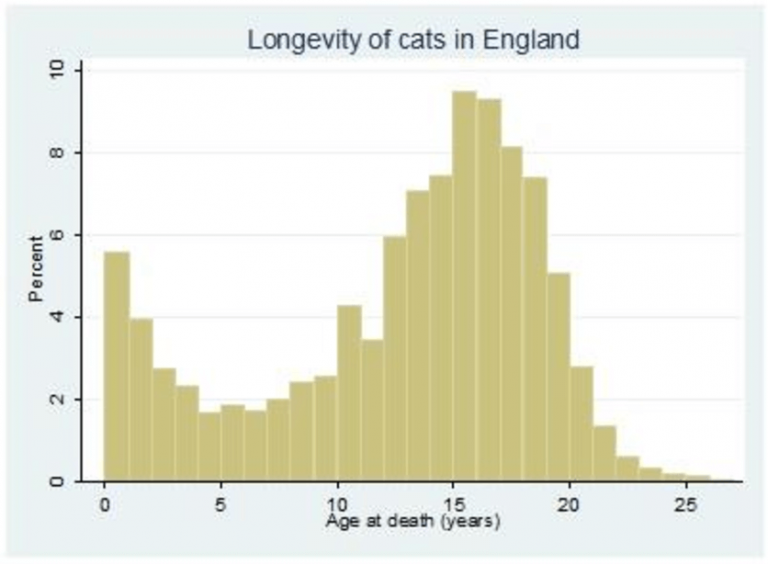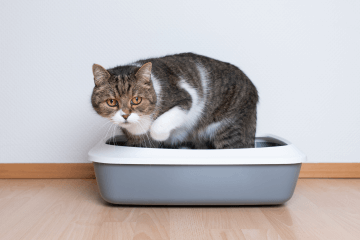With our cats Garrus and Wrex about to turn 5 years old, I wondered how cat years are calculated in human years. And: How long do cats live? Do indoor cats live longer than outdoor cats? So I researched these questions and will now present to you everything I’ve learned about cats and their age and life expectancy.
Table of Contents
How long do cats live on average?
On average, cats live to be 14 years old, while many make it to 15 or 16. It’s not even rare for cats to live to be 19, but after that their life expectancy drops dramatically and only very few cats live to be up to 25 years old. According to Guiness World Records, the oldest cat in the world lived to be 38 years old.
To find out what the life expectancy of cats is, I first consulted Wikipedia. While they had an answer (15 to 20 years), their source were random blogs (almost like mine!) which never mentioned their sources. I was more interested in a scientific study, however, so I looked for one – and I wasn’t disappointed. In a study with the lovely title Longevity and mortality of cats attending primary-care veterinary practices in England (.pdf), scientists of the Royal Veterinary College in England und the University of Sydney in Australia studied the life expectancy of cats at length.
They had data on 118,000 cats in a veterinary database and randomly picked 4,000 of them that had died, then they analysed that data. The median age cats reached was 14 years. Mortality rates spiked in their first as well as their 16th year.

Median vs. average
Let’s take a moment to look at this in greater detail. What does it mean if the median is 14 years? I called everything “average” until I realized the report actually keeps mentioning “median longevity”.
A median is the value in a set of values that is in the middle, i.e. it has the same number of values above it and below it. Contary to that, the average is a value derived from adding all the values and then dividing by the number of values.
So let’s assume I have a list of cats, and these are the ages at which they passed away: 1, 1, 4, 6, 10, 11, 11, 12, 14, 14, 23. When looking for the median value, I list all these ages and take the value in the middle of these (or if there is an even number of values, I take the average of the two middle values). So int his case we have:
| 1 |
| 1 |
| 4 |
| 6 |
| 10 |
| 11 (median) |
| 11 |
| 12 |
| 14 |
| 14 |
| 23 |
We get the average value by adding all these values (1 + 1 + 4 + 6 + 10 + 11 +
11 + 12 + 14 + 14 + 23 = 107) and then dividing by the number of available
values (107 : 11 = 9.73).
So in this case, we get a median of 11 years and an average value of 9.73 years. The advantage of a median is that extremes don’t have very much weight. As we saw above, many cats live to be 16 and 17 years old. If we have one unusual cat that lives to be 38, our median remains at 11, but the average would suddenly rise to 12.1 years.
Breed and castration

Back to the scientific study: Purebred cats have a median age of 12.5 years, cats of mixed breeds have a median age of 14 years. Male cats have a median age of 13, which is two years shorter than their female counterparts who lived to be 15. Wheter or not your cat is spayed or neutered also makes a difference: Spayed or neutered cats have a median age of 15 years, intact cats have a median age of 11 years. The scientists who conducted the study point out that cats who die very young (e.g. if they get hit by a car) often have not been neutered yet, and their data showed that many young cats got hit by cars. As for purebred cats: Birmans have the highest median life expectancy with 16.1 years, Bengal cats only have the lowest median life expectancy with only 7.3 years.
Car accidents, indoor cats and diseases
The study consisted of 3300 cats with a known cause of death (which is to say the cause of death was noted in the files), of which 12.2% died of injuries – and 60% of those were car accidents. A fraction less, 12.1% of cats, died of renal disease (i.e. kidney problems).
The age of death further shows that of the cats who died up until 5 years of age, almost half of them died of injuries, whereas only 5.8% of cats who lived longer than 5 years died of injuries. The biggest killer for cats who died older than 5 was renal failure, which killed 13.6% of them. One possible way to interpret these results is that a cat who lives to be five years old without dying of a traffic collision is adept enough at handling traffic to not die of it anymore. This also means that if you keep your cat indoors, one of the biggest risks for an early death automatically disappears.
Let’s go back to cats who live longer than 5 years: For 11.2%, the disease that killed them wasn’t specified in detail, for 10.8% it was neoplasia, which seems to be a tumor.
For kittens younger than 5 years old, viruses and respiratory problems were the most likely causes of death besides injuries.

Weight and insurance
Other factors that influence a cat’s life expectancy: Heavy cats have a lower life expectancy than light cats and cats with insurance live less long than cats without an insurance. The study notes the hypothesis that this might be due to insurance getting more expensive for older cats, so many people might give up their insurance for older cats. I don’t know if this is true – my cats aren’t insured at all because our consumer advice center doesn’t recommend them. (Of course, if you’re forgoing an insurance, you should still put money aside regardless so you do have the mean for any medical emergencies of your pets.)
How long did the oldest cat live?
In the study, the oldest cat lived to be 25, which is a proud long life, but Wikipedia and Guiness World Records tells me that the all-time record is at 38 years. That cat was called Creme Puff und lived in Austin, Texas. I don’t know if I believe it was really fed on bacon, eggs, broccoli, asparagus and coffee with cream. Generally, that’s NOT the recommended diet for your cat.
How do you calculate cat years in human years?
The first six months equal 10 human years. A 2-year-old cat is roughly 24 in human years. From two years old, you add an extra 4 human years for every cat year, so a 3-year-old cat is 28, a 4-year-old cat is 32 and so on.
The age of a cat in human years is not an exact science and I’ve found several contradicting sources. There are also tables that will differentiate between indoor cats and outdoor cats, which I think is a bit silly. After all, a cat is not really older by having a higher risk of dying early because of cars. The way of calculating above is one I found in several places, however, and it makes sense to me, which is why I’m reproducing it here. Here’s a convenient list of cat years in human years:
| 0 – 1 month | 0 – 1 year |
| 2 – 3 months | 2 – 4 years |
| 3 – 4 months | 6 – 8 years |
| 6 months | 10 years |
| 7 months | 12 years |
| 12 months | 15 years |
| 18 months | 21 years |
| 2 years | 24 years |
| 3 years | 28 years |
| 4 years | 32 years |
| 5 years | 36 years |
| 6 years | 40 years |
| 7 years | 44 years |
| 8 years | 48 years |
| 9 years | 52 years |
| 10 years | 56 years |
| 11 years | 60 years |
| 12 years | 64 years |
| 13 years | 68 years |
| 14 years | 72 years |
| 15 years | 76 years |
| 16 years | 80 years |
| 17 years | 84 years |
| 18 years | 88 years |
| 19 years | 92 years |
| 20 years | 96 years |
| 21 years | 100 years |
| 22 years | 104 years |
| 23 years | 108 years |
| 24 years | 112 years |
| 25 years | 116 years |
So in a few days, my cats will be 36 years old. Congrats, Garrus and Wrex! I hope they live long, healthy lives.



0 Comments